Holy Lands of Sabarimala
The Journey
After the Sarva-praayaschitha the pilgrim turns to the east, and the Guruswami, with his mind surging with devotion to Lord Ayyappa, places the lrumudikettu on the head of the pilgrim. The pilgrim then, with prayers to the Lord breaks a coconut by hurling it on a stone, symbolizing the shattering of impediments for a smooth pilgrimage. He now starts the journey in the company of the team led by the Guruswami. Although now-a-days the whole journey is rather convenient, in olden days when the pilgrims were fewer, the journey through dense forests was dangerous and the pilgrim would embark upon the journey putting his firm faith in Lord's Grace and protection. People at home would also be in a prayerful mood till the pilgrim returns safe.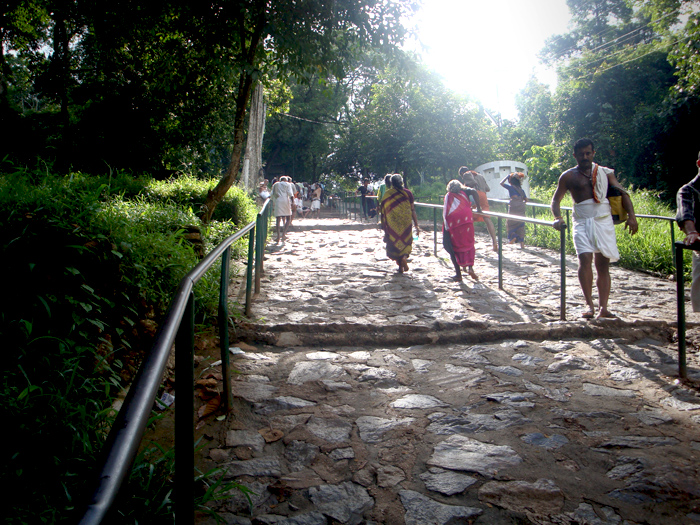
From Erumeli there are three ways to reach Pampa. By two routes, the pilgrims can reach Pampa in vehicles -one by Erumeli- Ranny-Plappilli road and the other by Erumeli Mukkoottuthar- Plappilli road. And the third, as mentioned above, is the traditional forest route of 50 kms to be trekked by foot up to Pampa. After road transport was extended up to Pampa, there was much reduction in the number of pilgrims going through the traditional route. However, the latest trend indicates that the pilgrims who prefer to reach the holy place walking bare foot through the forest path, are on the increase.
The Petta-thullal at Erumeli
At Erumeli there are three sacred spots, which the pilgrims visit. They are the two shrines of Lord Dharma Saastha, the Kochambalam (small shrine) and the Valiambalam (bigger shrine) and the mosque of Vaavar. The pilgrims who go to Sabarimala via Erumeli reach this place in vehicles and after participating in a ritualistic dance called Petta-thullal and worship at the shrines either proceed to Pampa in vehicles or by foot through the forest path. (There is also a road leading direct to Pampa without touching Erumeli.)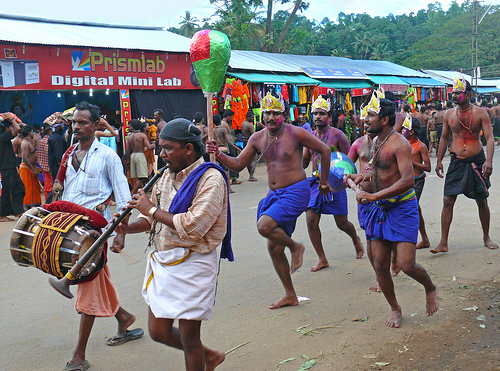 Erumeli wears a festive look during the whole pilgrimage season. Especially, a week before Makara-samkrama pooja, the most important Pooja, takes place in Sabarimala temple, Erumeli becomes an unforgettable scene of thousands of devotees clad in blue or black clothes in devotionalal abandon.
Erumeli wears a festive look during the whole pilgrimage season. Especially, a week before Makara-samkrama pooja, the most important Pooja, takes place in Sabarimala temple, Erumeli becomes an unforgettable scene of thousands of devotees clad in blue or black clothes in devotionalal abandon.Petta-thullal, a devotional dance, performed by the pilgrims in Erumeli, is an important ritualistic Custom of the pilgrimage. In the last chapter we have seen that there are Puraanic as well as historical views on the Ayyappa lore. The authors of the Puraana- s, as We have noted, linked mythological stories with historica1 incidents to convey messages and principles. According to the Puraanic view, the Petta-thullal is a re-enaction of the joyful dance of the people on knowing that Ayyappa had slain the terrible Mahishi, the demoness having the form of a she-buffalo. It is believed that' the place derived its name 'Erumeli' from the Malayalam word Eruma-kolli'. (Eruma means she-buffalo, and kolli, the place of killing.) Of course, the slaying of the buffalo here has a deeper connotation, that of eliminating or transcending the lower mental propensities for the evolution of human consciousness. Mahishi, the she-buffalo, symbolizes the underdeveloped stage of consciousness in animals, with its uncontrolled impulsive trends, which still hold a sway over human consciousness also.
According to the historical perspective, which is also given in the last chapter, Petta-thullal was a part of the spiritual discipline evolved by Ayyappa before embarking upon his war expedition against the despotic Udayanan to liberate Sabarimala temple from his hold. It was intended to erase the sense of all social and religious distinctiq9s from the minds of the participants and to integrate them into a dynamic whole. All of them wore blue or black clothes and smeared their faces with charcoal and other colours. They danced in abandon in a state of forgetfulness of their individual distinctions while making a conscious effort to fix their attention on the divinity of Ayyappa, whom they considered as the manifestation of the Supreme Reality. While dancing, they uttered aloud "Ayyappan thinthakathom, Sw'ami thinthakathom ", which is chanted even today by the dancing pilgrims. They were thus made to forget their lower nature and to fix their mind on the Supreme Reality. Thus both the mythological and historical points of view converge to the same message of evolution -of transcending the lower nature to evolve to Divine Consciousness.
The preparations for the Petta-thullal of a group, according to tradition, is to be arranged by the Randaam-kanni-swami-s (those who undertake the pilgrimage for the second time) as instructed by the Guruswami. One who is going for the first time is known a s a Kanni- Ayyappan. According to the tradition during the Petta-thullal the Kalmi-Ayyappa holds a symbolic arrow. It is customarily stipulated that the Kanni-Ayyappa, the first-timer, should participate in the Petta-thullal. Others mayor may not. However, for the thrill of devotional abandon and for the joy that is derived from thus transcending the egoistic trends and to directly experience at least a certain touch of Divine Consciousness of oneness with everything, many pilgrims enthusiastically take part in the ritualistic dance.
Before Petta-thullal begins the pilgrims go to the market (Petta means market and Thullal, dance) and buy small arrows for "ritualistic purpose, provisions as cereals, vegetables etc. (The arrow is to be discarded as a ritualistic gesture under a banyan tree called Saramkuttiyaal, atop the mountain Neelimala, beyond Pampa. The symbolism involved in this act is given later.) All these items of a group are placed in a blanket and then tied up into a bundle. The bundle is carried suspended on long poles, the ends of which rest on the shoulders of a pair of pilgrims.
The pilgrims with the face and body smeared with charcoal and other colours go to the Kochambalam, the smail shrine of Dharma Shaastha, from where the Petta-thullal begins. After worshiping at the shrine, the pilgrims start the dance to the accompaniment of instrumenta1 music, like drumming and Naagawaram. Petta-thullal is performed with devotional tervour, many of the pilgrims holding green twigs and uttering aloud:
From the Kochambalam, the dancing pilgrims move first to the mosque of Vaavar, and circumambulate it. They render their offerings and receive the sacred ash from a Muslim priest. It is a remarkable scene of a practical demonstration of the spirit of India's all embracing spiritual heritage that sees the diverse religious pursuits as just different paths to the same spiritual goal. According to Ayyappa lore, Ayyappa himself set up a special place of prayer for his Muslim lieutenant Vaavar and his followers. There now stands the mosque of Vaavar. During the annual festival (Chirappu Mahothsavam) of the Dharma Saastha Temple at Erumeli, the Hindus make offerings by going in procession to the mosque of Vaavar. And during the Chandanakkudam festival of the mosque, the Muslims go to the Dharma Saastha temple and make the offerings. Irrespective of the religious differences, for the people of this locality, these are great occasions for religious co-operation.
After coming out of the mosque the dancing pilgrims move towards Valiambalam, the bigger temple of Dharma Saastha, about a kilometre away on a river bank. On reaching Valiambalam, the pilgrims throw the green twigs over the roof of the temple and after circumambulation and worship, conclude the Petta-thullal by lighting camphor in front of the temple. Then they take bath in the river.
Petta-thullal is a symbolic hunting dance. The beasts hunted are the Shadvairies, the six enemies of man which are the negative Psychological trends that keep man in a state of stagnancy and arrest the evolutionary development of his consciousness. The group dance fills the mind with an inexplicable spiritual abandon that serves to reduce mental stress by releasing pent-up emotions and elevating the mind to experience joy, transcending the sense of egoistic self-importance and worldly distinctions.
Many pilgrims who go to Sabarimala reach Erumeli and after participating in the ritualistic dance and worshipping at the Kochambalam (small shrine), Vaver's mosque and Valiamblam (big shrine) proceed in vehicles to Pampa, on the bank of the river by the same name, or make a trek by toot of about 50 kms. through dense forests and high mountains to reach Pampa. From there they climb the mountain Neelimala to reach the Presence of Lord Ayyappa.
The Appearance of the Auspicious Eagle, Krishna Parunthu
Although the Petta-thullal of pilgrims reaching Erumeli Ifrom various places, takes place on all days during the pilgrimage season; according to age-old tradition, the Petta-thullal of two major groups of pilgrims, one from Ambalapuzha and the other from Alangad, will be performed only on the 27th of Malayalam month, Dhanu (around the J I th January). These groups represent the two major i1)iJitia of warriors from Ambalapuzha and Alangad (a peace near Kodungallu.r) who h.ad accompanied Ayyappa during his confrontation with the brIgand chief Udayanan.
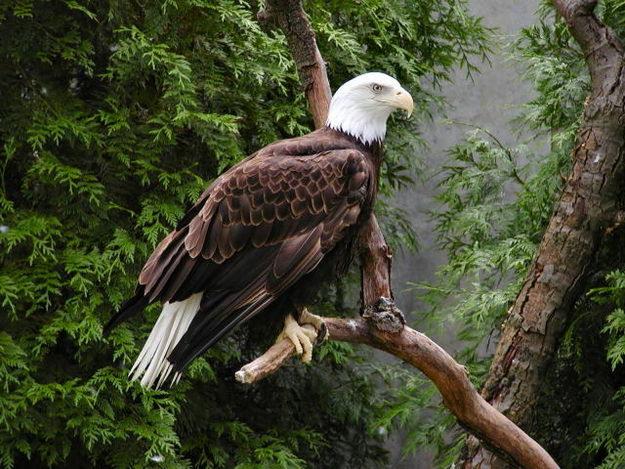
To study this phenomenon of the eagle's appearance, We had been to Erumeli on one such occasion on the particular day. With some anxiety of having been late, we reached the place about I 1.20 a.m., but were relieved to find that thousands were waiting on the terraces of the buildings scanning the skies for the Krishna Parunthu. There were no birds in the vast space except for some darting crows. We waited there for about ten minutes. Then, suddenly loud invocations of 'Swamiye Saranam Ayyappa' rent the air. We saw high up in the skies, above the Kochambalam, the Krishna Parunthu making rounds. It seemed as if the bird appeared all of a sudden from the depths of the skies. After a few rounds, it descended a little, flew straight towards the east and disappeared from sight. Then the Petta-thullal of the Ambalapuzha array of pilgrims began.
It was a very colourful event with three caparisoned elephants carrying the idols of the Deities. As a custom, one of the caparisoned elephants and the pilgrims in the procession entered the mosque of Vaavar, as the Muslims from the top of the mosque showered flowers on them. The elephant and the pilgrims then circumambulated the mosque. Emerging out, the Petta-thullal proceeded to the Valiambalam to end there.
Another major Petta-thullal, which is conducted by the group \of pilgrims from Alangad, takes place the same day afternoon. And on this occasion, as has been witnessed by many every year, a star will be visible in broad day light.
A Clue for the Higher Spiritual Links in the Universe
The auspicious phenomenon of the appearance of the Krishna Parunthu occurs also on some other special occasions, like just before the procession carrying the Thiruvaabharanam, the special ornaments of the Lord, starts from the Pandalam Palace, and also when the procession reaches Saramkuthiyaal, a sacred spot near Sabarimala Temple. These occurrences, as if programmed, take place every year and can be regarded as Nature's clues reminding man of the all-pervading Reality behind all phenomena. Such events serve to remind him of the greater dimensions in Nature beyond what he knows in his ordinary conditioned state. However, more than such supra-rational incidents, it is the very intimacy with the inner Divinity which the pilgrimage provides that draws millions to Sabarimala.
During the pilgrimage season Erumeli witnesses memorable scenes of abounding devotion, colour and festivity. Thousands of pilgrims on reaching here either proceed to Pampa by vehicles or take to the forest route by foot to reach there. In Erumeli, near the Valiambalam, there is a camp of the Akhila Bharatha Ayyappa Seva Sangham, a well-known voluntary organization, which renders considerable service to pilgrims.
The Traditional Forest Route
Pilgrims going through the forest route are comparatively less during the first phase of the pilgrim season, that is, during the Mandala-pooja season, between the1st Vrischikam (mid-November) and the 11th Dhanu (end of December); but during the Makara- samkrama phase beginning from the I st January, a large number of pilgrims go by this route.
 Till about two decades ago, the pilgrims taking to the forest route used to step directly into the forests immediately after Erumeli, but now he has to walk at least 4 kms through public roads before entering the forests. On the way there is a broad stream called Peroorthodu, once considered the boundary that separated the inhabited land from the forests. But now villages extend from here up to a place called Irumpoonnikkara, 3 kms eastwards. At Irumpoonnikkara there are three temples, dedicated to Lord Shiva, Sri Subrahmanya and Goddess Balabhadra Devi.
Till about two decades ago, the pilgrims taking to the forest route used to step directly into the forests immediately after Erumeli, but now he has to walk at least 4 kms through public roads before entering the forests. On the way there is a broad stream called Peroorthodu, once considered the boundary that separated the inhabited land from the forests. But now villages extend from here up to a place called Irumpoonnikkara, 3 kms eastwards. At Irumpoonnikkara there are three temples, dedicated to Lord Shiva, Sri Subrahmanya and Goddess Balabhadra Devi.Immediately after Irumpoonnikkara, the pilgrims enter dense ! tropical forests. Many prefer to walk bare foot through the holy mountain ranges, considered to be the Poonkaavanam. the blooming grove of Lord Ayyappa.
After about 3 kms walk, crossing some of the gentle forest streams, the pilgrim reaches a place of rest known as Arasumudikotta, where it is believed that Ayyappa and his soldiers took rest for some time. It is a place of worship of the Guardian Deities of the forests and there is a small shrine for them. Then the pilgrim proceeds ahead through a forest path that lies along the side of a river called ; Paarathode, the crystal clear water of which frisks and roll about ! amidst the rocks. It is .an ideal place for a refreshing cool bath.
Kalaketti
An important centre of pilgrimage in the forests, after leaving Erumeli, is a place called Kalaketti, about I I kms from there. After cljmbing one or two hill slopes the path to Kalaketti is rather even. It is a sacred spot and there is a temple of Lord Shiva. In the vast space around the temple, the pilgrims take rest under the big forest trees. There are temporary catering centres where fruits and light refreshments are available. According to the Puraanic version this is the place where Lord Shiva tied his bull mount and watched the dance of Ayyappa over the body of the slain Mahishi. The historical version has .it that Ayyappa tethered the bull he was riding to an Aanjili tree here and his soldiers also took rest here and evolved the strategies to siege the fortresses of Udayanan.Azhutha
During the Makara-samkrama season, especially after the 1st January, Azhutha and surrounding areas become a scene of constant movement of millions of pilgrims. Here there is an office of the Akhila Thiruvithamcore Mala Araya Mahasabha, an organisation of a mountain-inhabiting community, who manage the temples at Kalaketti, Azhutha, Inchippara, Mukkhuzhi, etc. At Azhutha there is a camp officeof Akhila Bharatha Ayyappa Seva Sangham, rendering service to the pilgrims.
The holy bath in the river Azhutha is a part of the pilgrimage. While making a dip, the pilgrim, as a ritualistic custom, takes a pebble from the river which he later drops on reaching a place called Kallidumkunnu, which literally means the hill where the stone is dropped, on the top of a mountain to which the pilgrim climbs next.
Wading through the rather shallow river, the pilgrim reaches the other side and makes about a 3-kms climb of a mountain side called Az'huthamedu. This is one of the three major steep climbs of the pilgrimage. (Moving from the banks of Azhutha to reach the banks of Pampa, a distance of about 37 kms, the pi 19rim pass through dense forests and two mountain peaks, Inchippara and Karimala. The pilgrims climb two mountain slopes to reach these peaks. Another climb on the way to Sabarimala is the slope of the Neelimala peak, which is beyond the river Pampa.)
Kallidumkunnu and Inchippara
The Azhuthamedu climb culminates at Kallidumkunnu and Inchippara, a little away from Kallidumkunnu. At Kallidumkunnu the pilgrim reverentially drops the pebble that he had picked up from the river Azhutha.According to the Puraanic lore, it is believed that Kallidumkunnu is the place where Mahishi's body lay buried. The historical point of view evolved from the old Ayyappan Pattukal, the ballads on Ayyappa, says that here were the deep trenches that protected Udayanan's fortress at Inchippara, and these trenches were filled up by Ayyappa's soldiers, who carried stones from and around the river Azhutha. The ritual of dropping the stone seems to commemorate that event.
Don't 'Improve' this Forest Path
At least the terrain between the banks of Azhutha and that of Pampa should be left as it is, without any 'improvement' in the name of making the journey 'more comfortable'. Of course, for many pilgrims, who have led a cosy life, a bare-foot journey through the rigged path would be an ordeal in the beginning; but later, even they will experience the truth of the slogan raised by the pilgrims "Kalium mullum kaalukku methai", -these stones and thorns are like carpet for the feet. And they find faith making them sturdier. As some believe, it may even have a healing impact as if from acupressure.
It is really a revealing experience as one looks at the face of the pilgrims. Many of them are immersed in the ecstatic mood of devotion forgetful of their fears, anxieties and sufferings. Even the old and the incapacitated can be seen trekking the forest path and it is faith that energises them to move on. The whole pilgrimage is designed to bring man closer to mother Nature and reinforce him physically, mentally and spiritually. The pilgrimage offers a rare opportunity to break the stagnating patterns of ordinary life and is a breakthrough to a rejuvenating spirituaJ experience. These dense reserve forests should be kept as it is, for an effective and meaningful i pilgrimage as designed by the great Rishi-s.
Walking a short distance from Kallidumkunnu over level ground, the pilgrim reaches Inchippara. There is a temple for the Guardian Deity Sri Inchippara Mooppan. This is a place of rest for the pilgrims who take refreshments or cook food. Akhila Bharatha Ayyappa Seva Sangham sets up a service camp here during the peak season.
Mukkuzhi
Now the pilgrim has to climb down a steep mountain slope that ends in a valley called Mukkuzhi, another ideal resting place and for the right stay. At Mukkuzhi there is a temple of Sri Ganesa and Divine Mother.Karimala
There is now an 11- kms. trek through thick foot-hill forests to reach the lofty mountain, Karimala. On the way there are a few places for rest and some temporary catering sheds where Kanji. the rice gruel, boiled tapioca with salad, tea, etc., will be available. These deep forests are ordinarily the regions where the denizens of the wilderness freely roam about, but they discreetly keep away when man dominates their havens once in a year for a few days. The pilgrim can see the droppings of wild elephants and other animals on the way. The blooming forests are a feast to the eyes.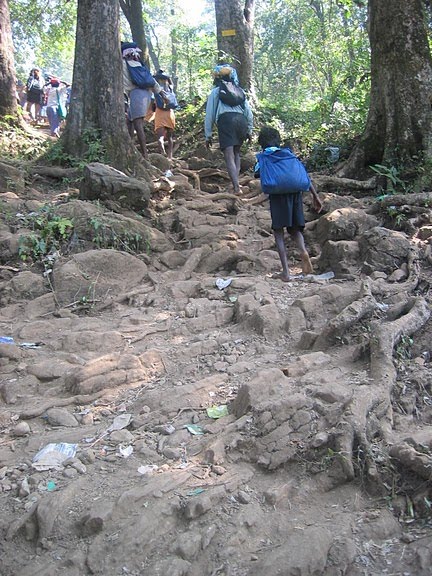 Eventually the pilgrim reaches the banks of the stream Kariyilaamthodu in the valley of the mountain Karimala. If he had started from Azhutha about 7 a.m. he would be reaching Kariyilaamthodu by I p.m. There are temporary sheds where the pilgrims can take rest. Many of them take bath in the forest stream, cook food or have it from the catering sheds.
Eventually the pilgrim reaches the banks of the stream Kariyilaamthodu in the valley of the mountain Karimala. If he had started from Azhutha about 7 a.m. he would be reaching Kariyilaamthodu by I p.m. There are temporary sheds where the pilgrims can take rest. Many of them take bath in the forest stream, cook food or have it from the catering sheds.Then the pilgrim crosses Kariyilaamthodu and walks about 3 kms through dense forests of the valley of Karimala. Then starts one of the most arduous climbs of the pilgrimage to reach the mountain top. While the Azhuthamedu involves almost one straight stretch of climb, the mountain of Karimala has to be climbed in seven stages and at every stage the pilgrim is likely to assume that he has reached the top, very much like what happens in the adventurous process of gaining knowledge, mundane or spiritual, when one often tends to make the mistake of thinking that he has known all that is there to be known, while there is still much left unknown.
It is said in the Ayyappa lore that atop Karimala there was a formidable fort of the brigand chief Udayanan and by conquering the fort and destroying Udayanan and his hordes, the ultimate aim of Ayyappa's expedition was achieved -the liberation of the temple of Sri DharmaSa!1stha of Sabarimala. In Karimala, there are places for the worship of the Deities Vana Durga, Karimalanaathan and Kochu Kadutha, who was one of the chieftains of Ayyappa. There are two ancient wells on the top of Karimala. It is believed that Ayyapppa and his soldiers quenched their thirst from these wells.
Valiyaanathaavalam
Reaching the top of Karimala, the pilgrim takes rest for sometime and then starts the adventurous climb down through very narrow and zig zag paths flanked by dense forests. He would often feel that it is an endless descent. Every step has to be carefully taken. At last, stepping into the valleys of Karimala, the pilgrim reaches a plain grass land interspersed with shrubs and the place is known as Valiyaanathaavalam on the bank of a tributary of river Pampa. Thousands of camp-sheds are here and many pilgrims stay in them immersing themselves in reading the holy texts and meditation. There is a camp of Akhila Bharatha Ayyappa Seva Sangham rendering service to the pilgrims. At the south-eastern corner of this place there is a raised platform which is the resting place for the Thiruvaabharanam, the ornaments, brought from the palace of Pandalam to adorn the idol of the Lord, during Makara-samkrama Pooja. Moving further the pilgrim reaches a spot called Cheriyaanathaavalam, another place with tall forest trees. Now the pilgrim walks along the banks of a tributary of the river Pampa.Pampa
The pilgrim reaches the extensive area of the Pampa river bed. The region is also known as Pampa. The Ayyappa lore has it that king Rajasekhara of Pandalam found the child Ayyappa on the banks of this river. The section, Kishkindaa-kaandam of the Ramayana, begins and ends with exquisite description of the scenic beauty around the holy river Pampa, where Sri Rama arrived during his wanderings in search of Sita. As there is no other river in the whole of India known by this name, it can be assumed that the Ramayana reference is about this river itself.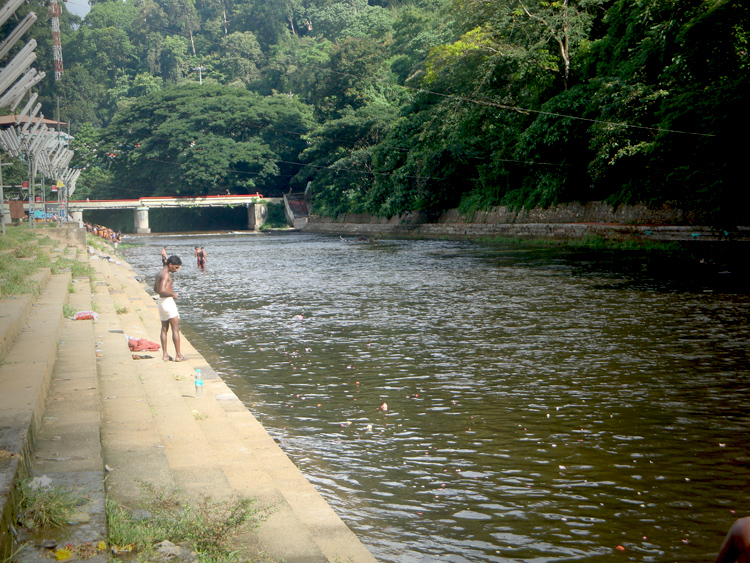
In the highly spiritual Malayalam poem, Adhyaathma Raamaayanam, composed by the 18th century poet, Raamaanujan Ezhuthachan (hailed as the 'Father of Modern Malayalam Literature') and famed for its literary excellence and which enjoys the highest demand in Kerala even today, the banks of Pampa are described as: "Pampa a sarasthadam lokamanoharam" -the banks of Pampa are most enchanting.
Flowing zig zag through mountain terrains and dense forests, river Pampa, when it reaches this region, becomes rather straight for some distance, with vast areas of plain land, especially on the Valiyaanathavalam side of the river bank. Here, there are hundreds of camp sheds for the pilgrims to stay. Some of the pilgrims would / stay for two to three days in this pious atmosphere on the banks of Pampa forgetting all their mundane affairs and immersing themselves in reading holy texts, prayer and meditation, Formerly, pilgrims used 1q bring their provisions and cook their own food. Now there are many catering centres at Pampa.
There are a few holy place.s around Pampa, especially associated with the Ramayana. About a kilometre and half above the river is the confluence of the tributaries, Kallaaru and Kakkaattaaru with Pampa. Near this holy confluence known as Triveni there is an embedded impression on a rock resembling human feet. It is believed to be that of Sri Rama, and is known as Sri Rama- paadam. One has to walk along the river bank beset with dense forests to reach this holy spot, which is located near the K.S.R. T.C Bus Station.
A decade ago Pampa was not accessible by road and pilgrims could go only up to Chalakkayam by vehicles and then had to walk a few kilometres to reach Pampa. Now there is a great flow of pilgrims who come by vehicles direct to Pampa. So Pampa looks like a township, but it is not an all-time inhabited town. Being located in the midst of reserve forests, it is more relevant to the Sabarimala pilgrimage only. It is almost a deserted place except during the pilgrimage season and also for about five days around the auspicious days of Vishu (in April), Thiruvonam (August-September) and for the first five days of each Malayalam month, when the temple remains opened for Pooja-s.
The Pithrubali at Pampa
On reaching Pampa, the pilgrims, after setting their camps, take a holy dip in the river, Pampa. Many of them perform the rite Pithrubali, the propitiatory rites for .the ancestors, expressing their love and regard for those who had passed away. There are specially trained priests who guide the pilgrims to perform the rites. It is mentioned in the Ramayana that Sri Rama performed Pithrubali on the banks of Pampa. The place also gained special importance in this respect after Ayyappa performed the rites for the soldiers, who were killed in the battle against Udayanan and his hordes.
Pampaa-sadya and Pampaa-vilakku
An important function which the pilgrims, who come in groups, arrange here is the ritualistic feast called Pampaa-sadya, a sumptuous feast commemorating the feast Ayyappa and his soldiers arranged at the banks of Pampa to celebrate the liberation of Sabarimala temple. The pilgrims believe that there will be the presence and participation of Lord Ayyappa as an unseen guest in the feast.
There is a festival of light on the banks of Pampa a day before the most important Makara-samkrama Pooja. This also' commemorates the victory Celebration on the banks of Pampa conducted after the defeat of Udayanan. Innumerable camps of 1 pilgrims are illuminated with oil lamps and candles on this occasion. ! Special floats are made, and placing well-lit lamps in them, they are set afloat in the river. The grand spectacle of thousands of such floats moving along the river will linger long in the memory. Besides this, the rhythmic sounds from the traditional musical instruments ~ and the loud chanting of 'Swamiye saranam Ayyappa' impart an ethereal atmosphere to the whole scene.
BHASMAKULAM PLACES OF SACRED DIP)
One sacred place for bath is Bhasmakulam. Pilgrims get purgated them selves by their dip in the holy water here. The legend says that Sabari entered the fire in the presence of Sri Rama and as a result her mortal remains were consumed. This pond has its name derived from this legend. Water in the pond is ever kept fresh and clean inspite of the constant use.
URAKUZHI THEERTHAM
The next place consecrated for holy bath is Kumbalam Thode with Urakuzhi Theertham in it. This holy canal is about one km north to Malikappuram. This place is believed as the most sacred place as Dharmasastha made his Darsan with Viswaroopa. Here there is a waterfall and a .small creek to which the water streams to. This creek, is named Urakuzhi. It seems to be a small hole. But when one sits in the bosom, it appears to be a creek spacious enough to have a cooldip. It is believed that a bath in' the Urakuzhi thecrtion wears off all the sins. Pilgrims never miss the opportunity to bathe in this Holytirtham in Kumbalam thode.
Neelimala
 Climbing the mountain Neelimala is the next phase of the pilgrimage. At first the pilgrim climbs the steps to reach the shrine of Sri Ganesha at the foot of the mountain and worships there before climbing up Neelimala. This is the third steep climb of the pilgrimage, when the, pilgrim takes to the traditional route. But for those who reach Pampa by vehicles, this is the only climb. (There is another route to be trekked by foot via Vandiperiyar that directly reaches Sabarimala witht out1ouchingPampa,) From Pampa, Sabarimala is about 6 kms. away. The pilgrims who are unable to climb, engage Dollies, the special carriers borne by a team of four persons. Near Sri Ganesha temple there is a camp of the king of Panda lam, the descendant of the foster father of Ayyappa, who stays there for a few days during the pilgrimage season. The pilgrims receive sacred ash from the king.
Climbing the mountain Neelimala is the next phase of the pilgrimage. At first the pilgrim climbs the steps to reach the shrine of Sri Ganesha at the foot of the mountain and worships there before climbing up Neelimala. This is the third steep climb of the pilgrimage, when the, pilgrim takes to the traditional route. But for those who reach Pampa by vehicles, this is the only climb. (There is another route to be trekked by foot via Vandiperiyar that directly reaches Sabarimala witht out1ouchingPampa,) From Pampa, Sabarimala is about 6 kms. away. The pilgrims who are unable to climb, engage Dollies, the special carriers borne by a team of four persons. Near Sri Ganesha temple there is a camp of the king of Panda lam, the descendant of the foster father of Ayyappa, who stays there for a few days during the pilgrimage season. The pilgrims receive sacred ash from the king. Appaachimedu
On the top of Neelimala there is a spot called Appaachimedu, on both sides of which there are very steep gorges. Appaachimedu is considered to be the seat of evil spirits and the pilgrims propitiate them by throwing offerings of rice-powder balls into the gorges. This is symbolic of the Advaithic vision that there is no phenomenon external to the Ultimate Reality. Both good and bad are conditioned expressions within Reality and the spiritual inquirer is making anSabaripeedam
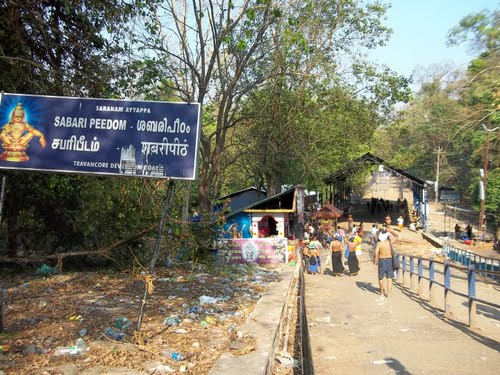 Now the great climb is over. The pilgrim is getting closer to his destination. Walking a short distance from Appaachimedu, he reaches a level ground and there is the sacred spot, Sabari-peedam. According to a legend, Sri Rama and his brother Lakshmana, during their wanderings in search of Sita, met the great woman sage Sabari at this place and enjoyed her hospitality. Therefore, the whole region including the location of the sacred shrine of Lord Ayyappa, is known as Sabarimala, the Hill of Sabari. The pilgrims make offerings and worship at the holy spot.
Now the great climb is over. The pilgrim is getting closer to his destination. Walking a short distance from Appaachimedu, he reaches a level ground and there is the sacred spot, Sabari-peedam. According to a legend, Sri Rama and his brother Lakshmana, during their wanderings in search of Sita, met the great woman sage Sabari at this place and enjoyed her hospitality. Therefore, the whole region including the location of the sacred shrine of Lord Ayyappa, is known as Sabarimala, the Hill of Sabari. The pilgrims make offerings and worship at the holy spot.Saramkuttiyaal
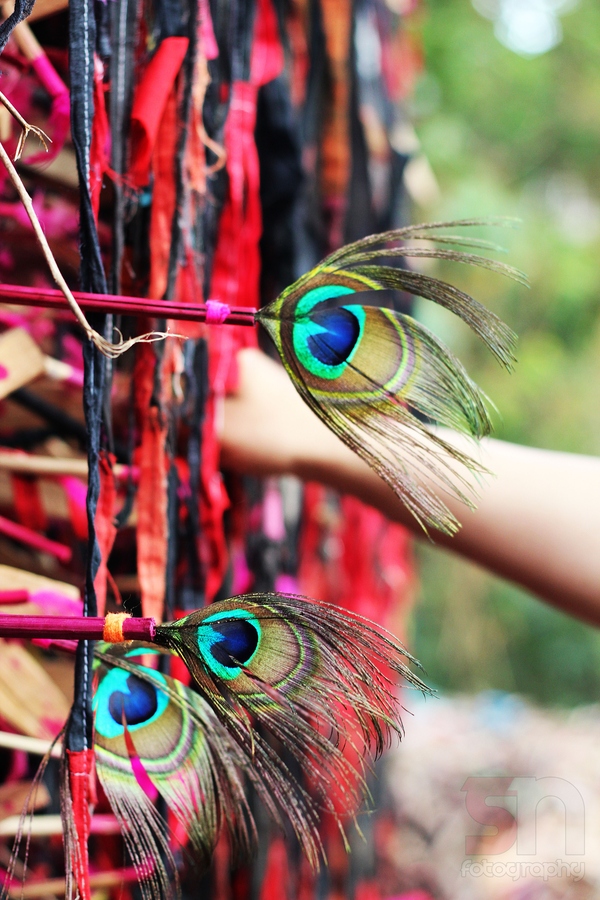
The pilgrim has now come very close, to the temple and the whole region is vibrant with loud chanting of the pilgrims and the :1 explosion of the fireworks offerings in the shrine.


